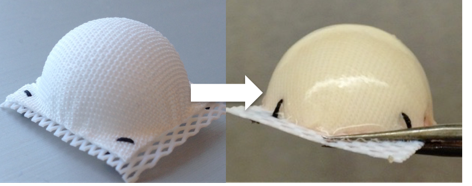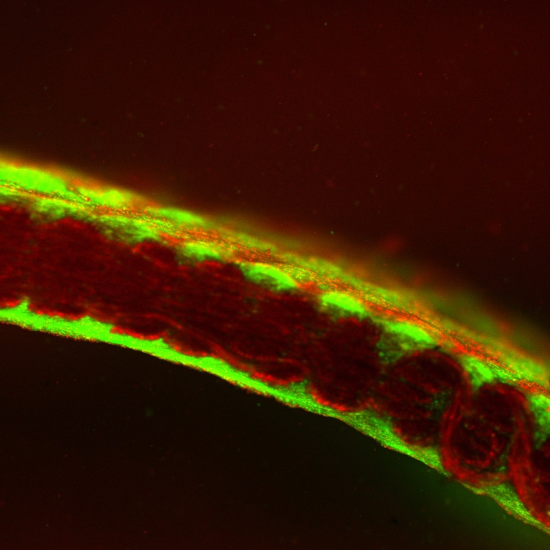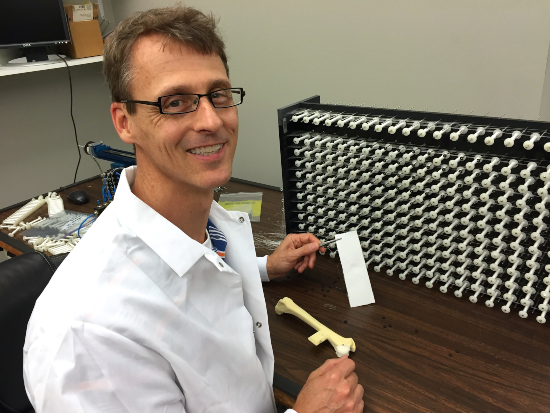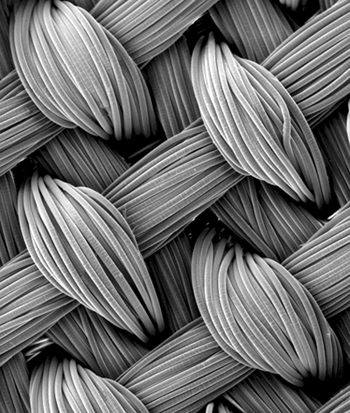Editor’s note: Startup Spotlight is a regular feature at WRAL TechWire, bringing attention to promising emerging companies across the Triangle and North Carolina as well as management and other issues.
+++
RESEARCH TRIANGLE PARK – If you’re not hip to having hip replacement surgery, CytexOrtho may soon have a different and – for some patients – better solution.
The Durham-based startup is developing an innovative new implant technology to restore cartilage and bone in damaged or diseased joints that don’t normally heal on their own. It also can prevent, or delay, the onset of osteoarthritis (OA), a progressive joint disorder caused by wearing down of cartilage that cushions the ends of bones. The initial focus is on the hip.

CytexOrtho hip implant before (left), after tissue regrowth. — CytexOrtho photos
The millions of patients in this country who suffer from osteoarthritis are acutely aware that the condition can often lead to severe joint pain, and even disability. Close to half a million hip replacement surgeries are performed in the United States each year, at a total cost of at least $6 billion. And about 92% of them are primarily the result of OA.
When a hip joint becomes so compromised that it affects a person’s quality of life, the only currently available permanent fix is to replace it.

Microscopic view of CytexOrtho fiber, tissue growth.
That can work well for older, more sedentary folks. But the surgery isn’t the best answer for younger and more active patients. They’re harder on their joints. And total hip prostheses don’t last forever – they need replacing, on average, in 15 to 20 years.
So, if you replace a hip when you’re in your 40s or 50s, you can pretty much count on doing it again a decade or two later. The surgery also is likely to leave a less-stable joint that is prone to more complications the second time around.
Add to that equation the rapidly growing number of younger people with serious hip injuries who undergo total hip replacements because there isn’t a better alternative. About a quarter of all these surgeries are performed on patients under 55 years old.
Changing the hip replacement paradigm
A paradigm change is needed, according to CytexOrtho CEO and co-founder Brad Estes, Ph.D. Healing damaged cartilage to avoid hip surgery is the ideal approach, he said, but solutions have so far been elusive.

Brad Estes at a loom weaving implant mesh.
Instead, surgeons address relatively small hip surface damage by cutting off the entire top portion of the hip ball and socket joint and replacing it with a combination of complex implant components that make up a total hip prosthesis. These man-made materials simply aren’t durable enough to last a lifetime for young, more active, patients.
Cytex hopes to provide a better and less-invasive alternative. The company’s novel technology combines a 3-D woven textile, which functions as cartilage, with a 3-D printed component that functions as bone. The implant also incorporates a patient’s own stem cells to make new cartilage and bone to create a fully functional joint. The implant dissolves over time, leaving behind the newly formed tissues that are integrated into the implant’s open structure.
“The key thing we’ve done is to develop an implant that behaves like normal cartilage as soon as it’s in place,” Estes said. Over time it transfers the functionality to the tissues in and around the implant, leaving only natural tissue behind.
“The cool thing,” he added, “is that the procedure only gets rid of the diseased tissue. So it’s much more tissue sparing than a hip replacement that requires the removal of significant healthy tissue to anchor the prosthesis in the leg and pelvis.”
Estes said the goal of the Cytex implant is “to restore the cartilage and leave all the healthy bone in place. We like to think of it not as hip replacement, but as hip restoration.”
The implant doesn’t guarantee that hip replacement surgery won’t ever be needed, but it can provide an option for earlier intervention, particularly with younger patients. And, at a minimum, it may delay more extensive surgery until later in life, so a second hip replacement isn’t necessary.
Working with the FDA to begin clinical trials

Microscopic view of woven mesh.
Cytex is working with the U.S. Food and Drug Administration to develop a protocol for human trials that it plans to begin early next year. Multiple preclinical studies conducted at North Carolina State University and Colorado State University have yielded promising results.
“If all goes well,” Estes said, “we could potentially launch a commercial hip implant in the next five or six years.” The company also hopes to develop implants for knee, shoulder, and ankle joints in the future.
Cytex’s scientific progress has been validated over the years by a wide variety of prestigious peer-reviewed scientific journals that include Science, Nature, and the Proceedings of the National Academy of Sciences. The technology is featured on the cover of the most recent (August 2022) Journal of Orthopaedic Research.
The company’s co-founders – Estes, Farshid Guilak, Ph.D., and Frank Moutos, Ph.D. – have received a prestigious Kappa Delta Elizabeth Lanier Award from the American Academy of Orthopaedic Surgeons as well. These awards recognize research in musculoskeletal disease or injury that has the greatest potential to advance patient care. They are the highest honors in the field of orthopaedic research.
Funding from the NIH, NCBiotech, NC IDEA
Most of Cytex’s $17.5 million in grant funding to date has come from the National Institutes of Health (NIH). These awards are highly competitive and based on rigorous scientific review. The North Carolina Biotechnology Center (NCBiotech) also has just given the company a Small Business Research Loan of $250,000 to help support the first-in-human clinical trial for the hip implant.
“CytexOrtho is developing a unique technology that has the potential to make a tremendous difference in many patients’ lives,” said Kathy Meserve, senior director of investments at NCBiotech. “We’re delighted to support the company in that endeavor.”
Estes said Cytex continues to look for new investors. “We’re thrilled we’re this close to the clinic with our technology and are actively looking for investors who can help our vision become a reality,” he pointed out. “We feel like the market is ripe for a paradigm-shifting technology and we’re excited to partner with those who can help us provide solutions for the millions of young and active patients who are battling hip disease.”
About CytexOrtho
Cytex was founded in 2006 by Estes; Guilak, who is chair of the Cytex board; and Moutos, the company’s vice president of technology development.
Earlier in his career, Guilak was a professor at Duke University Medical Center, where Estes and Moutos received doctorates in biomedical engineering. During that time, Guilak and his team developed the implant technology that won the university’s Fuqua School of Business “Duke Start-Up Challenge,” which led to the incorporation of Cytex.
The company was soon awarded an NC IDEA grant and its first NIH award to kickstart the research behind its novel implant technology. Since then – through multiple federal, state, and private grants – Cytex has grown to a staff of nine scientists and administrators who are working to bring the potentially game-changing technology to the clinic.
(C) N.C. Biotech Center





























